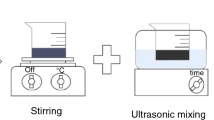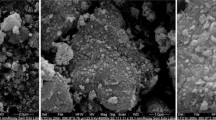Abstract
The thermal reaction properties of the aluminum nanoparticles/copper (II) oxide nanoparticles/poly(vinylidene fluoride) (Al-NPs/CuO-NPs/PVDF) nanocomposite (mass ratio of Al-NPs/CuO-NPs/PVDF = 20/60/20) were investigated by means of thermogravimetry–differential scanning calorimetry–mass spectrometry (TG/DSC-MS) and X-ray diffraction (XRD) analysis. Al-NPs/PVDF (mass ratio of Al-NPs/PVDF = 50/50) and CuO-NPs/PVDF (mass ratio of CuO-NPs/PVDF = 75/25) nanocomposites were also prepared as a comparison. It is observed that PVDF in the Al-NPs/PVDF nanocomposite acts as an oxidizer. The fluorine ions/fluorinated gases formed at elevated temperatures react with the Al2O3 shell leading to the formation of aluminum fluoride (AlF3). The oxide shell is degraded from the reaction between fluoride ions and Al2O3, leaving the core Al available for reaction with fluorine ions/fluorinated gases. H +2 (m/z = 2), OH+ (m/z = 17), H2O+ (m/z = 18), HF+ (m/z = 20), CF+ (m/z = 31) and CH2F+ (m/z = 33) fragments were detected in the gaseous products. For CuO-NPs/PVDF nanocomposite, oxygen was released due to the decomposition of CuO to Cu2O and then Cu metal, oxidizing hydrocarbon groups in PVDF. Species of OH+ (m/z = 17), H2O+ (m/z = 18), CO +2 (m/z = 44), C2H2F+ (m/z = 45) and HF+ (m/z = 20) were detected in the gaseous products. The final reduction product of CuO is Cu metal. It is observed that PVDF in the Al-NPs/CuO-NPs/PVDF nanocomposite acts as both oxidizer and reducer in the thermal decomposition. Below 550 °C, PVDF is oxidized by CuO-NPs and oxidizing Al-NPs at the same time, resulting mass reduction. After 550 °C, the remaining Al-NPs and copper (I)/copper (II) oxide will proceed the exothermic solid-state thermite reaction. OH+ (m/z = 17), H2O+ (m/z = 18), CO +2 (m/z = 44), C2H2F+ (m/z = 45) and HF+ (m/z = 20) were the main products of the decomposition of Al-NPs/CuO-NPs/PVDF nanocomposite.









Similar content being viewed by others
References
Sullivan K, Young G, Zachariah MR. Enhanced reactivity of nano-B/Al/CuO MIC’s. Combust Flame. 2009;156(2):302–7.
Yetter RA, Risha GA, Son SF. Metal particle combustion and nanotechnology. Proc Combust Inst. 2009;32(2):1819–38.
Meda L, Marra G, Galfetti L, Severini F, De Luca L. Nanoaluminum as energetic material for rocket propellants. Mater Sci Eng, C. 2007;27(5):1393–6.
Sadeghipour S, Ghaderian J, Wahid M. Advances in aluminum powder usage as an energetic material and applications for rocket propellant. In Proceedings of the 4th International Meeting of Advances in Thermalfluids (IMAT 2011). 2012.
Parthiban S, Jain SR, Ragunandan B. Interpenetrating polymer networks as binders for solid composite propellants. Def Sci J. 2013;42:147–9.
Yan S, Jian G, Zachariah MR. Electrospun nanofiber-based thermite textiles and their reactive properties. ACS Appl Mater Interfaces. 2012;4:6432–3.
Li X, Liu X, Cheng Y, Li Y, Mei X. Thermal decomposition properties of double-base propellant and ammonium perchlorate. J Therm Anal Calorim. 2014;115:887–94.
Miller HA, Kusel BS, Danielson ST, Neat JW, Avjian EK, Pierson SN, Budy SM, Ball DW, Iacono ST, Kettwich SC. Metastable nanostructured metallized fluoropolymer composites for energetics. J Mater Chem A. 2013;1:7050–8.
Smith DW, Iacono ST, Boday DJ, Kettwich SC. In advances in fluorine-containing polymers. Dayton: American Chemical Society; 2012.
Sanders VE, et al. Reaction propagation of four nanoscale energetic composites (Al/MoO3, Al/WO3, Al/CuO, and Bi2O3). J Propul Power. 2007;23(4):707–14.
Wang HY, et al. Assembly and reactive properties of Al/CuO based nanothermite microparticles. Combust Flame. 2014;161(8):2203–5.
Pantoya ML, et al. Effect of bulk density on reaction propagation in nanothermites and micron thermites. J Propul Power. 2009;25(2):465–70.
Zhou X, et al. Highly exothermic and superhydrophobic Mg/fluorocarbon core/shell nanoenergetic arrays. ACS Appl Mater Interf. 2014;6:10497–8.
Zhou X, et al. CuO/Mg/fluorocarbon sandwich-structure superhydrophobic nanoenergetic composite with anti-humidity property. Chem Eng J. 2015;266:163–7.
Meeks K, Pantoya ML, Apblett C. Deposition and characterization of energetic thin films. Combust Flame. 2014;161:1117–24.
Ball W, Iacono ST, Kettwich SC. Metastable nanostructured metallized fluoropolymer composites for energetics. J Mater Chem A. 2013;1:7050–8.
Osborne DT, Pantoya ML. Effect of Al particle size on the thermal degradation of Al/teflon mixtures. Combust Sci and Tech. 2007;179:1467–80.
Kubota N, Serizawa C. Combustion of magnesium/polytetrafluoroethylene. J Propul Power. 1987;9:539–45.
Watson KW, Pantoya ML, Levitas VI. Fast reactions with nano- and micrometer aluminum: a study on oxidation versus fluorination. Combust Flame. 2008;155:619–34.
Koch EC. Metal-Fluorocarbon-Pyrolants: III. Development and application of magnesium/teflon/viton (MTV). Propellants Explos Pyrotech. 2002;27:262–4.
Yarrington CD, Son SF, Foley TJ. Combustion of silicon/teflon/viton and aluminum/teflon/viton energetic composites. J Propul Power. 2010;26(4):734–9.
Datta S, et al. Reaction dynamics and probability study of aluminum-viton-acetone droplets. J Propul Power. 2011;27(2):396–401.
Huang C, Jian G, DeLisio JB, Wang H, Zachariah MR. Electrospray deposition of energetic polymer nanocomposites with high mass particle loadings: a prelude to 3D printing of rocket motors. Adv Eng Mater. 2015;17(1):95–6.
Li X, Guerieri P, Zhou W, Huang C, Zachariah MR. Direct deposit laminate nano-composite with enhanced propellant properties. ACS Appl Mater Interfaces. 2015;7(17):9103–6.
Huang C, et al. Characterization of aluminum/poly (vinylidene fluoride) by thermogravimetric analysis, differential scanning calorimetry, and mass spectrometry. Anal Lett. 2015. doi:10.1080/00032719.2015.1012675.
McHale JM, Auroux A, Perrotta AJ, Navrotsky A. Surface energies and thermodynamic phase stability in nanocrystalline aluminas. Science. 1997;1997(277):788–91.
Jia WZ, Lu JQ, Chen P, Wang YJ, Luo MF. A novel method for the synthesis of well-crystallized β-AlF3 with high surface area derived from γ-Al2O3. J Mater Chem. 2011;21:8987–90.
Umbrajkar SM, Mirko S, Dreizin EL. Exothermic reactions in Al-CuO nanocomposites. Thermochim Acta. 2006;451(1):34–9.
Wang H, DeLisio JB, Jian G. Electrospray formation and combustion characteristics of iodine-containing Al/CuO nanothermite microparticles. Combust Flame. 2015;162(7):2823–6.
Puts GJ, Crouse PL. The influence of inorganic materials on the pyrolysis of polytetrafluoroethylene: part 2: The common oxides of Al, Ga, In, Zn, Cu, Ni Co, Fe, Mn, Cr, V. Zr and La. J Fluorine Chem. 2014;168:9–15.
Acknowledgements
This work was supported by the Key Laboratory Fund (9140C370304140C37173).
Author information
Authors and Affiliations
Corresponding author
Electronic supplementary material
Below is the link to the electronic supplementary material.
Rights and permissions
About this article
Cite this article
Li, X., Huang, C., Yang, H. et al. Thermal reaction properties of aluminum/copper (II) oxide/poly(vinylidene fluoride) nanocomposite. J Therm Anal Calorim 124, 899–907 (2016). https://doi.org/10.1007/s10973-015-5194-8
Received:
Accepted:
Published:
Issue Date:
DOI: https://doi.org/10.1007/s10973-015-5194-8




